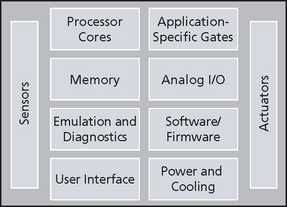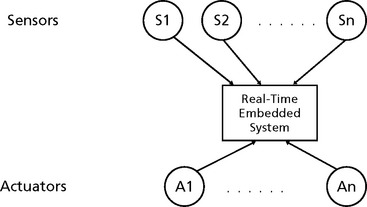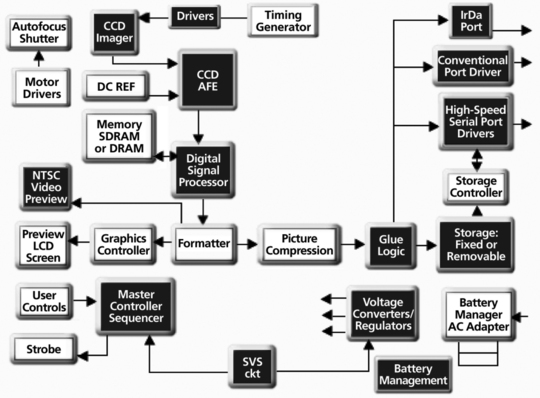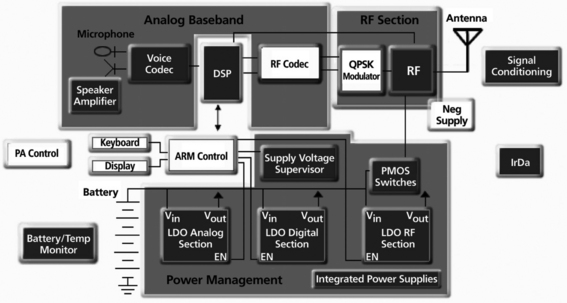Overview of Embedded Systems and Real-Time Systems
Introduction
Nearly all real-world DSP applications are part of an embedded real-time system. While this book will focus primarily on the DSP-specific portion of such a system, it would be naive to pretend that the DSP portions can be implemented without concern for the real-time nature of DSP or the embedded nature of the entire system.
This chapter will highlight some of special design considerations that apply to embedded real-time systems. I will look first at real-time issues, then some specific embedded issues, and finally, at trends and issues that commonly apply to both realtime and embedded systems.
Real-Time Systems
A real-time system is a system that is required to react to stimuli from the environment (including the passage of physical time) within time intervals dictated by the environment. The Oxford Dictionary defines a real-time system as “any system in which the time at which output is produced is significant.” This is usually because the input corresponds to some movement in the physical world, and the output has to relate to that same movement. The lag from input time to output time must be sufficiently small for acceptable timeliness. Another way of thinking of real-time systems is any information processing activity or system which has to respond to externally generated input stimuli within a finite and specified period. Generally, real-time systems are systems that maintain a continuous timely interaction with their environment (Figure 2.1).

Figure 2.1 A real-time system reacts to inputs from the environment and produces outputs that affect the environment
Types of real-time systems—soft and hard
Correctness of a computation depends not only upon its results but also upon the time at which its outputs are generated A real-time system must satisfy response time constraints or suffer significant system consequences. If the consequences consist of a degradation of performance, but not failure, the system is referred to as a soft realtime system. If the consequences are system failure, the system is referred to as a hard real-time system. (for instance, anti-lock braking systems in an automobile).
Hard Real-Time and Soft Real-Time Systems
Hard real-time and soft real-time systems introduction
A system function (hardware, software, or a combination of both) is considered hard real-time if, and only if, it has a hard deadline for the completion of an action or task. This deadline must always be met, otherwise the task has failed. The system may have one or more hard real-time tasks as well as other nonreal-time tasks. This is acceptable, as long as the system can properly schedule these tasks in such a way that the hard real-time tasks always meet their deadlines. Hard real-time systems are commonly also embedded systems.
DSP Systems are Hard Real-Time
Usually, DSP systems qualify as hard real-time systems. As an example, assume that an analog signal is to be processed digitally. The first question to consider is how often to sample or measure an analog signal in order to represent that signal accurately in the digital domain. The sample rate is the number of samples of an analog event (like sound) that are taken per second to represent the event in the digital domain. Based on a signal processing rule called the Nyquist rule, the signal must be sampled at a rate at least equal to twice the highest frequency that we wish to preserve. For example, if the signal contains important components at 4 kilohertz (kHZ), then the sampling frequency would need to be at least 8 KHz. The sampling period would then be:
Based on signal sample, time to perform actions before next sample arrives
This tells us that, for this signal being sampled at this rate, we would have 0.000125 seconds to perform all the processing necessary before the next sample arrives. Samples are arriving on a continuous basis, and the system cannot fall behind in processing these samples and still produce correct results—it is hard real-time.
Hard real-time systems
The collective timeliness of the hard real-time tasks is binary—that is, either they will all always meet their deadlines (in a correctly functioning system), or they will not (the system is infeasible). In all hard real-time systems, collective timeliness is deterministic. This determinism does not imply that the actual individual task completion times, or the task execution ordering, are necessarily known in advance.
The feasibility and costs (for example, in terms of system resources) of hard real-time computing depend on how well known a priori are the relevant future behavioral characteristics of the tasks and execution environment. These task characteristics include:
• timeliness parameters, such as arrival periods or upper bounds
• resource utilization profiles
There are also pertinent characteristics relating to the execution environment:
Deterministic collective task timeliness in hard (and soft) real-time computing requires that the future characteristics of the relevant tasks and execution environment be deterministic—that is, known absolutely in advance. The knowledge of these characteristics must then be used to pre-allocate resources so all deadlines will always be met.
Usually, the task’s and execution environment’s future characteristics must be adjusted to enable a schedule and resource allocation that meets all deadlines. Different algorithms or schedules that meet all deadlines are evaluated with respect to other factors. In many real-time computing applications, it is common that the primary factor is maximizing processor utilization.
Allocation for hard real-time computing has been performed using various techniques. Some of these techniques involve conducting an offline enumerative search for a static schedule that will deterministically always meet all deadlines. Scheduling algorithms include the use of priorities that are assigned to the various system tasks. These priorities can be assigned either offline by application programmers, or online by the application or operating system software. The task priority assignments may either be static (fixed), as with rate monotonic algorithms1 or dynamic (changeable), as with the earliest deadline first algorithm2.
Real-Time Event Characteristics
In many real-time systems, task and future execution environment characteristics are hard to predict. This makes true hard real-time scheduling infeasible. In hard real-time computing, deterministic satisfaction of the collective timeliness criterion is the driving requirement. The necessary approach to meeting that requirement is static (that is, a priori3) scheduling of deterministic task and execution environment characteristic cases. The requirement for advance knowledge about each of the system tasks and their future execution environment to enable offline scheduling and resource allocation significantly restricts the applicability of hard real-time computing.
Efficient Execution and the Execution Environment
Efficiency overview
Real-time systems are time critical, and the efficiency of their implementation is more important than in other systems. Efficiency can be categorized in terms of processor cycles, memory or power. This constraint may drive everything from the choice of processor to the choice of the programming language. One of the main benefits of using a higher level language is to allow the programmer to abstract away implementation details and concentrate on solving the problem. This is not always true in the embedded system world. Some higher level languages have instructions that be an order of magnitude slower than assembly language. However, higher level languages can be used in real-time systems effectively, using the right techniques. We will be discussing much more about this topic in the chapter on optimizing source code for DSPs.
Resource management
A system operates in real time as long as it completes its time-critical processes with acceptable timeliness. Acceptable timeliness is defined as part of the behavioral or “nonfunctional” requirements for the system. These requirements must be objectively quantifiable and measurable (stating that the system must be “fast,” for example, is not quantifiable). A system is said to be real-time if it contains some model of real-time resource management (these resources must be explicitly managed for the purpose of operating in real time). As mentioned earlier, resource management may be performed statically, offline, or dynamically, online.
Real-time resource management comes at a cost. The degree to which a system is required to operate in real time cannot necessarily be attained solely by hardware over-capacity (such as, high processor performance using a faster CPU). To be cost effective, there must exist some form of real-time resource management. Systems that must operate in real time consist of both real-time resource management and hardware resource capacity. Systems that have interactions with physical devices require higher degrees of real-time resource management. These computers are referred to as embedded systems, which we spoke about earlier. Many of these embedded computers use very little real-time resource management. The resource management that is used is usually static and requires analysis of the system prior to it executing in its environment. In a real-time system, physical time (as opposed to logical time) is necessary for real-time resource management in order to relate events to the precise moments of occurrence. Physical time is also important for action time constraints as well as measuring costs incurred as processes progress to completion. Physical time can also be used for logging history data.
All real-time systems make trade-offs of scheduling costs vs. performance in order to reach an appropriate balance for attaining acceptable timeliness between the real-time portion of the scheduling optimization rules and the offline scheduling performance evaluation and analysis.
Challenges in Real-Time System Design
Designing real-time systems poses significant challenges to the designer. One of these challenges comes from the fact that real-time systems must interact with the environment. The environment is complex and changing and these interactions can become very complex. Many real-time systems don’t just interact with one, but many different entities in the environment, with different characteristics and rates of interaction. A cell phone base station, for example, must be able to handle calls from literally thousands of cell phone subscribers at the same time. Each call may have different requirements for processing and be in different sequences of processing. All of this complexity must be managed and coordinated.
Real-time systems must respond to external interactions in the environment within a predetermined amount of time. Real-time systems must produce the correct result and produce it in a timely way. This implies that response time is as important as producing correct results. Real-time systems must be engineered to meet these response times. Hardware and software must be designed to support response time requirements for these systems. Optimal partitioning of the system requirements into hardware and software is also important.
Real-time systems must be architected to meet system response time requirements. Using combinations of hardware and software components, engineering makes architecture decisions such as interconnectivity of the system processors, system link speeds, processor speeds, memory size, I/O bandwidth, etc. Key questions to be answered include:
Is the architecture suitable? – To meet the system response time requirements, the system can be architected using one powerful processor or several smaller processors. Can the application be partitioned among the several smaller processors without imposing large communication bottlenecks throughout the system. If the designer decides to use one powerful processor, will the system meet its power requirements? Sometimes a simpler architecture may be the better approach—more complexity can lead to unnecessary bottlenecks which cause response time issues.
Are the processing elements powerful enough? – A processing element with high utilization (greater than 90%) will lead to unpredictable run time behavior. At this utilization level, lower priority tasks in the system may get starved. As a general rule, real-time systems that are loaded at 90% take approximately twice as long to develop, due to the cycles of optimization and integration issues with the system at these utilization rates. At 95% utilization, systems can take three times longer to develop, due to these same issues. Using multiple processors will help, but the inter-processor communication must be managed.
Are the communication speeds adequate? – Communication and I/O are a common bottleneck in real-time embedded systems. Many response time problems come not from the processor being overloaded but in latencies in getting data into and out of the system. On other cases, overloading a communication port (greater than 75%) can cause unnecessary queuing in different system nodes and this causes delays in message passing throughout the rest of the system.
Is the right scheduling system available? – In real-time systems, tasks that are processing real-time events must take higher priority. But, how do you schedule multiple tasks that are all processing real-time events? There are several scheduling approaches available, and the engineer must design the scheduling algorithm to accommodate the system priorities in order to meet all real-time deadlines. Because external events may occur at any time, the scheduling system must be able to preempt currently running tasks to allow higher priority tasks to run. The scheduling system (or realtime operating system) must not introduce a significant amount of overhead into the real-time system.
Recovering from Failures
Real-time systems interact with the environment, which is inherently unreliable. Therefore, real-time systems must be able to detect and overcome failures in the environment. Also, since real-time systems are often embedded into other systems and may be hard to get at (such as a spacecraft or satellite) these systems must also be able to detect and overcome internal failures (there is no “reset” button in easy reach of the user!). Also since events in the environment are unpredictable, its almost impossible to test for every possible combination and sequence of events in the environment. This is a characteristic of real-time software that makes it somewhat nondeterministic in the sense that it is almost impossible in some real-time systems to predict the multiple paths of execution based on the nondeterministic behavior of the environment. Examples of internal and external failures that must be detected and managed by real-time systems include:
Distributed and Multiprocessor Architectures
Real-time systems are becoming so complex that applications are often executed on multiprocessor systems distributed across some communication system. This poses challenges to the designer that relate to the partitioning of the application in a multiprocessor system. These systems will involve processing on several different nodes. One node may be a DSP, another node a more general-purpose processor, some specialized hardware processing elements, etc. This leads to several design challenges for the engineering team:
Initialization of the system – Initializing a multiprocessor system can be very complicated. In most multiprocessor systems, the software load file resides on the general-purpose processing node. Nodes that are directly connected to the general-purpose processor, for example a DSP, will initialize first. After these nodes complete loading and initialization, other nodes connected to them may then go through this same process until the system completes initialization.
Processor interfaces – When multiple processors must communicate with each other, care must be taken to ensure that messages sent along interfaces between the processors are well defined and consistent with the processing elements. Differences in message protocol, including endianness, byte ordering and other padding rules, can complicate system integration, especially if there is a system requirement for backwards compatibility.
Load distribution – As mentioned earlier, multiple processors lead to the challenge of distributing the application, and possibly developing the application to support efficient partitioning of the application among the processing elements. Mistakes in partitioning the application can lead to bottlenecks in the system and this degrades the full capability of the system by overloading certain processing elements and leaving others under utilized. Application developers must design the application to be partitioned efficiently across the processing elements.
Centralized Resource Allocation and Management – In systems of multiple processing elements, there is still a common set of resources including peripherals, cross bar switches, memory, etc that must be managed. In some cases the operating system can provide mechanisms like semaphores to manage these shared resources. In other cases there may be dedicated hardware to manage the resources. Either way, important shared resources in the system must be managed in order to prevent more system bottlenecks.
Embedded Systems
An embedded system is a specialized computer system that is usually integrated as part of a larger system. An embedded system consists of a combination of hardware and software components to form a computational engine that will perform a specific function. Unlike desktop systems which are designed to perform a general function, embedded systems are constrained in their application. Embedded systems often perform in reactive and time-constrained environments as desribed earlier. A rough partitioning of an embedded system consists of the hardware which provides the performance necessary for the application (and other system properties like security) and the software, which provides a majority of the features and flexibility in the system. A typical embedded system is shown in Figure 2.3.
• Processor core – At the heart of the embedded system is the processor core(s). This can be a simple inexpensive 8 bit microcontroller to a more complex 32 or 64 bit microprocessor. The embedded designer must select the most cost sensitive device for the application that can meet all of the functional and nonfunctional (timing) requirements.
• Analog I/O – D/A and A/D converters are used to get data from the environment and back out to the environment. The embedded designer must understand the type of data required from the environment, the accuracy requirements for that data, and the input/output data rates in order to select the right converters for the application. The external environment drives the reactive nature of the embedded system. Embedded systems have to be at least fast enough to keep up with the environment. This is where the analog information such as light or sound pressure or acceleration are sensed and input into the embedded system (see Figure 2.4 below).
• Sensors and Actuators – Sensors are used to sense analog information from the environment. Actuators are used to control the environment in some way.
• Embedded systems also have user interfaces. These interfaces may be as simple as a flashing LED to a sophisticated cell phone or digital still camera interface.
• Application-specific gates – Hardware acceleration like ASICs or FPGA are used for accelerating specific functions in the application that have high performance requirements. The embedded designer must be able to map or partition the application appropriately using available accelerators to gain maximum application performance.
• Software is a significant part of embedded system development. Over the last several years, the amount of embedded software has grown faster than Moore’s law, with the amount doubling approximately every 10 months. Embedded software is usually optimized in some way (performance, memory, or power). More and more embedded software is written in a high level language like C/C++ with some of the more performance critical pieces of code still written in assembly language.
• Memory is an important part of an embedded system and embedded applications can either run out of RAM or ROM depending on the application. There are many types of volatile and nonvolatile memory used for embedded systems and we will talk more about this later.
• Emulation and diagnostics – Many embedded systems are hard to see or get to. There needs to be a way to interface to embedded systems to debug them. Diagnostic ports such as a JTAG (joint test action group) port are used to debug embedded systems. On-chip emulation is used to provide visibility into the behavior of the application. These emulation modules provide sophisticated visibility into the runtime behavior and performance, in effect replacing external logic analyzer functions with on board diagnostic capabilities.
Embedded systems are reactive systems
A typical embedded system responds to the environment via sensors and controls the environment using actuators (Figure 2.5). This imposes a requirement on embedded systems to achieve performance consistent with that of the environment. This is why embedded systems are referred to as reactive systems. A reactive system must use a combination of hardware and software to respond to events in the environment, within defined constraints. Complicating the matter is the fact that these external events can be periodic and predictable or aperiodic and hard to predict. When scheduling events for processing in an embedded system, both periodic and aperiodic events must be considered and performance must be guranteed for worst-case rates of execution. This can be a significant challenge. Consider the example in Figure 2.6. This is a model of an automobile airbag deployment system showing sensors including crash severity and occupant detection. These sensors monitor the environment and could signal the embedded system at any time. The embedded control unit (ECU) contains accelerometers to detect crash impacts. Also, rollover sensors, buckle sensors and weight sensors (Figure 2.8) are used to determine how and when to deploy airbags. Figure 2.7 shows the actuators in this same system. These include Thorax bags actuators, pyrotechnic buckle pretensioner with load limiters and the central airbag control unit. When an impact occurs, the sensors must detect and send a signal to the ECU, which must deploy the appropriate airbags within a hard real-time deadline for this system to work properly.

Figure 2.6 Airbag system: possible sensors (including crash severity and occupant detection) (courtesy of Texas Instruments)
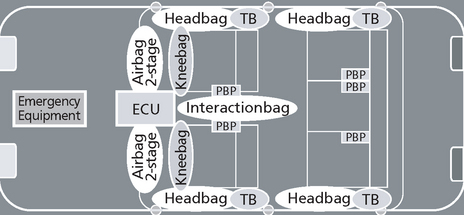
Figure 2.7 Airbag system: possible sensors (including crash severity and occupant detection) (courtesy of Texas Instruments)
The previous example demonstrates several key characteristics of embedded systems:
• Monitoring and reacting to the environment – Embedded systems typically get input by reading data from input sensors. There are many different types of sensors that monitor various analog signals in the evironment, including temperature, sound pressure, and vibration. This data is processed using embedded system algorithms. The results may be displayed in some format to a user or simply used to control actuators (like deploying the airbags and calling the police).
• Control the environment – Embedded systems may generate and transmit commands that control actuators such as airbags, motors, and so on.
• Processing of information – Embedded systems process the data collected from the sensors in some meaningful way, such as data compression/decompression, side impact detection, and so on.
• Application-specific – Embedded systems are often designed for applications such as airbag deploment, digital still cameras or cell phones. Embedded systems may also be designed for processing control laws, finite state machines, and signal processing algorithms. Embedded systems must also be able to detect and react appropriately to faults in both the internal computing environment as well as the surrounding systems.
SAT = satellite with serial communication interface
ECU = central airbag control unit (including accelerometers)
Figure 2.9 shows a block diagram of a digital still camera (DSC). A DSC is an example of an embedded system. Referring back to the major components of an embedded system shown in Figure 2.3 we can see the following components in the DSC:
• The charge-coupled device analog front-end (CCD AFE) acts as the primary sensor in this system.
• The digital signal processor is the primary processor in this system.
• The battery management module controls the power for this system.
• The preview LCD screen is the user interface for this system.
• The Infrared port and serial ports are actuators in this system that interface to a computer.
• The graphics controller and picture compression modules are dedicated application-specific gates for processing accleration.
Figure 2.10 shows another example of an embedded system. This is a block diagram of a cell phone. In this diagram, the major components of an embedded system are again obvious:
• The antenna is one of the sensors in this system. The microphone is another sensor. The keyboard also provides aperiodic events into the system.
• The voice codec is an application-specific acceleration in hardware gates.
• The DSP is one of the primary processor cores which runs most of the signal processing algorithms.
• The ARM processor is the other primary system processor running the state machines, controlling the user interface, and other components in this system.
• The battery/temp monitor controls the power in the system along with the supply voltage supervisor.
Summary
Many of the items that we interface with or use on a daily basis contain an embedded system. An embedded system is a system that is “hidden” inside the item we interface with. Systems such as cell phones, answering machines, microwave ovens, VCRs, DVD players, video game consoles, digital cameras, music synthesizers, and cars all contain embedded processors. A late model car contains more than 60 embedded microprocessors. These embedded processors keep us safe and comfortable by controlling such tasks as antilock braking, climate control, engine control, audio system control, and airbag deployment.
Embedded systems have the added burden of reacting quickly and efficiently to the external “analog” environment. That may include responding to the push of a button, a sensor to trigger an air bag during a collision, or the arrival of a phone call on a cell phone. Simply put, embedded systems have deadlines that can be hard or soft. Given the “hidden” nature of embedded systems, they must also react to and handle unusual conditions without the intervention of a human.
DSPs are useful in embedded systems principally for one reason; signal processing. The ability to perform complex signal processing functions in real time gives DSP the advantage over other forms of embedded processing. DSPs must respond in real time to analog signals from the environment, convert them to digital form, perform value added processing to those digital signals, and, if required, convert the processed signals back to analog form to send back out to the environment.
We will discuss the special architectures and techniques that allow DSPs to perform these real-time embedded tasks so quickly and efficiently. These topics are discussed in the coming chapters.
Programming embedded systems requires an entirely different approach from that used in desktop or mainframe programming. Embedded systems must be able to respond to external events in a very predictable and reliable way. Real-time programs must not only execute correctly, they must execute on time. A late answer is a wrong answer. Because of this requirement, we will be looking at issues such as concurrency, mutual exclusion, interrupts, hardware control and processing, and more later in the book because these topics become the dominant considerations. Multitasking, for example, has proven to be a powerful paradigm for building reliable and understandable real-time programs.
1Rate monotonic analysis (RMA) is a collection of quantitative methods and algorithms that allow engineers to specify, understand, analyze, and predict the timing behavior of real-time software systems, thus improving their dependability and evolvability.
2A strategy for CPU or disk access scheduling. With EDF, the task with the earliest deadline is always executed first.
3Relating to or derived by reasoning from self-evident propositions (formed or conceived beforehand), as compared to a posteriori that is presupposed by experience (www.wikipedia.org).

